Abstract
1. In conscious non-pregnant and pregnant ewes and in chronic fetal lamb preparations, the beat by beat relationship between pulse interval and systolic pressure was studied during acute elevations in arterial pressure induced by phenylephrine. Baroreflex sensitivity, which was defined as the slope of the pressure-pulse interval relationship when phenylephrine was used to raise pressure, was abolished by atropine and increased by propranolol. Baroreflex sensitivity was less in pregnant ewes and in foetal lambs compared with non-pregnant ewes. 2. These findings suggest that the vagus nerve is responsible for the reflex bradycardia that occurs in the foetus and the ewe when arterial pressure is increased. 3. In both fetal and adult sheep, actue hypertension due to I.V. injection of angiotensin II was not associated with a consistent and progressive bradycardia, such as was seen with acute hypertension caused by phenylephrine. Angiotensin II has no direct chronotropic effect on heart rate in either the adult or the fetus. 4. No linear relationship between arterial pressure and pulse interval was seen when angiotensin II was used to raise pressure in sheep which were treated with propranolol. Therefore the lack of cardiac slowing with pressor doses of angiotensin II was not due to concomitant activation of the sympathoadrenal system. 5. It is concluded that in both fetal and adult sheep angiotensin II reduces the increase in vagal tone which is responsible for slowing of heart rate in response to acute rises in arterial pressure.
Full text
PDF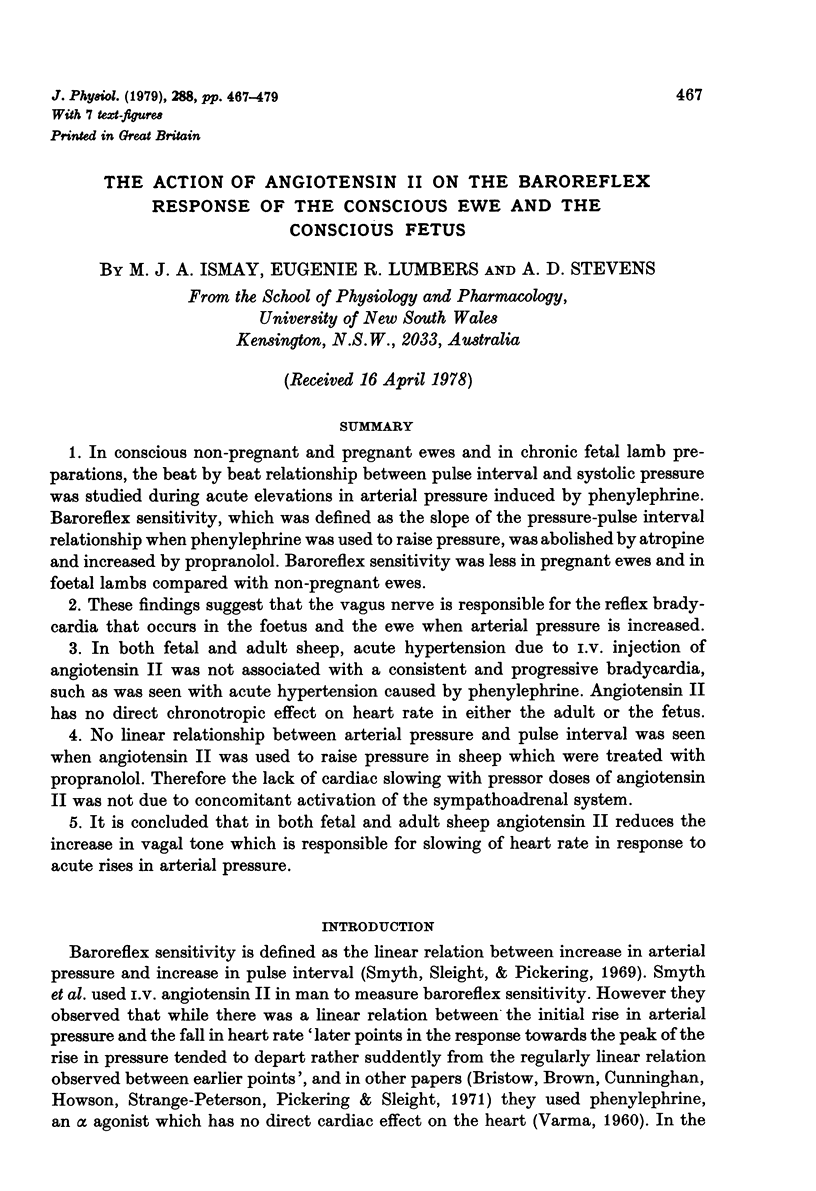
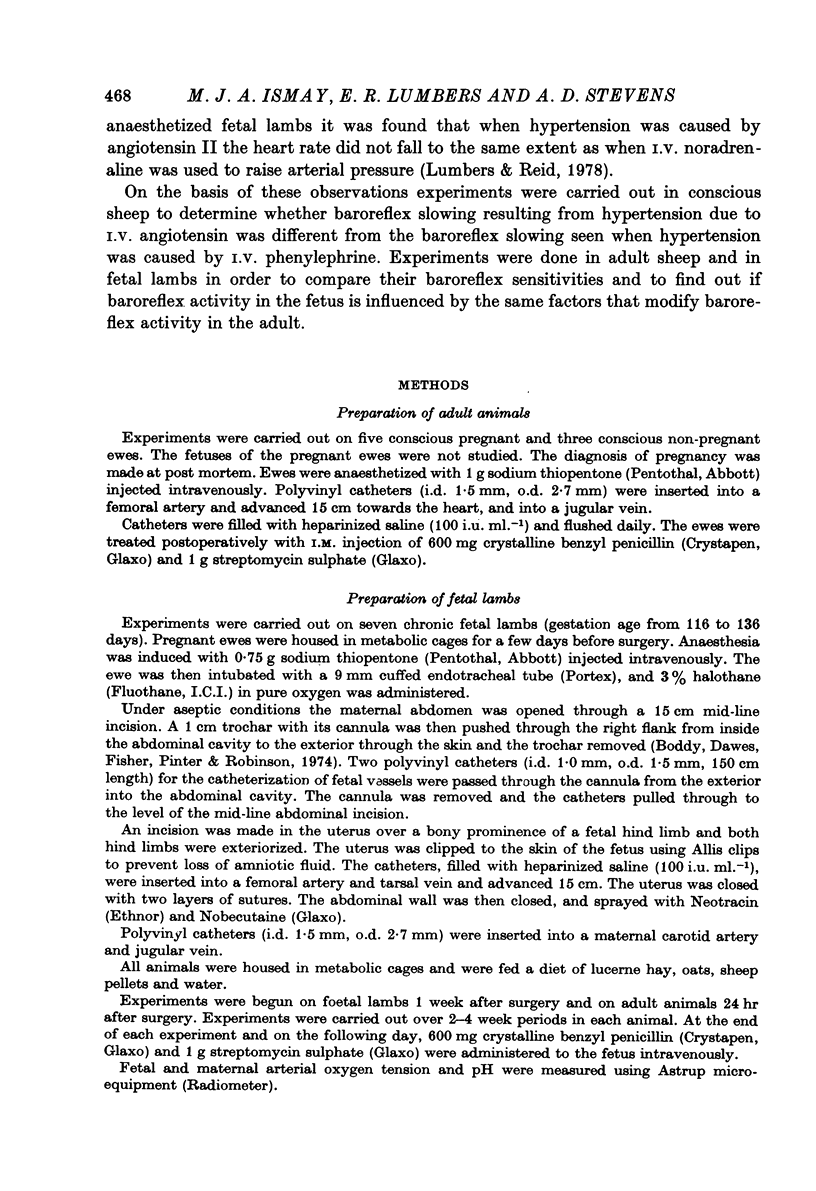
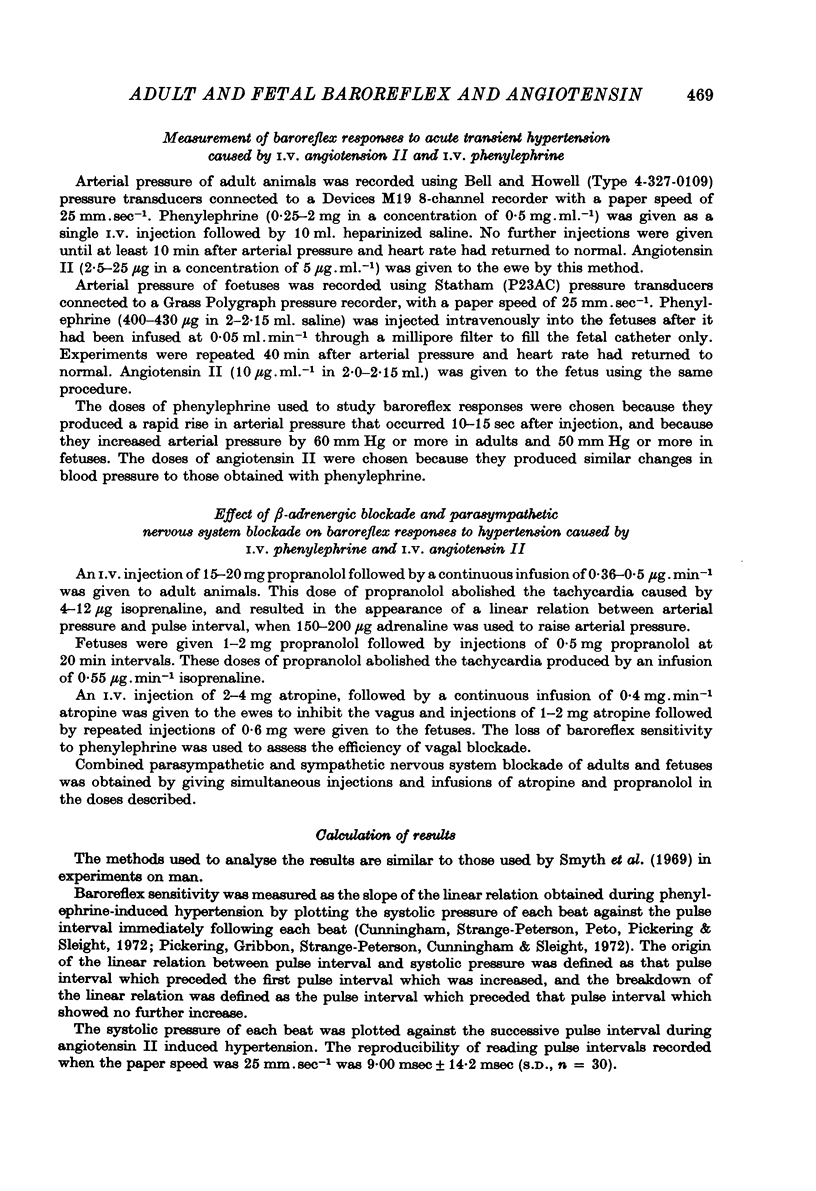
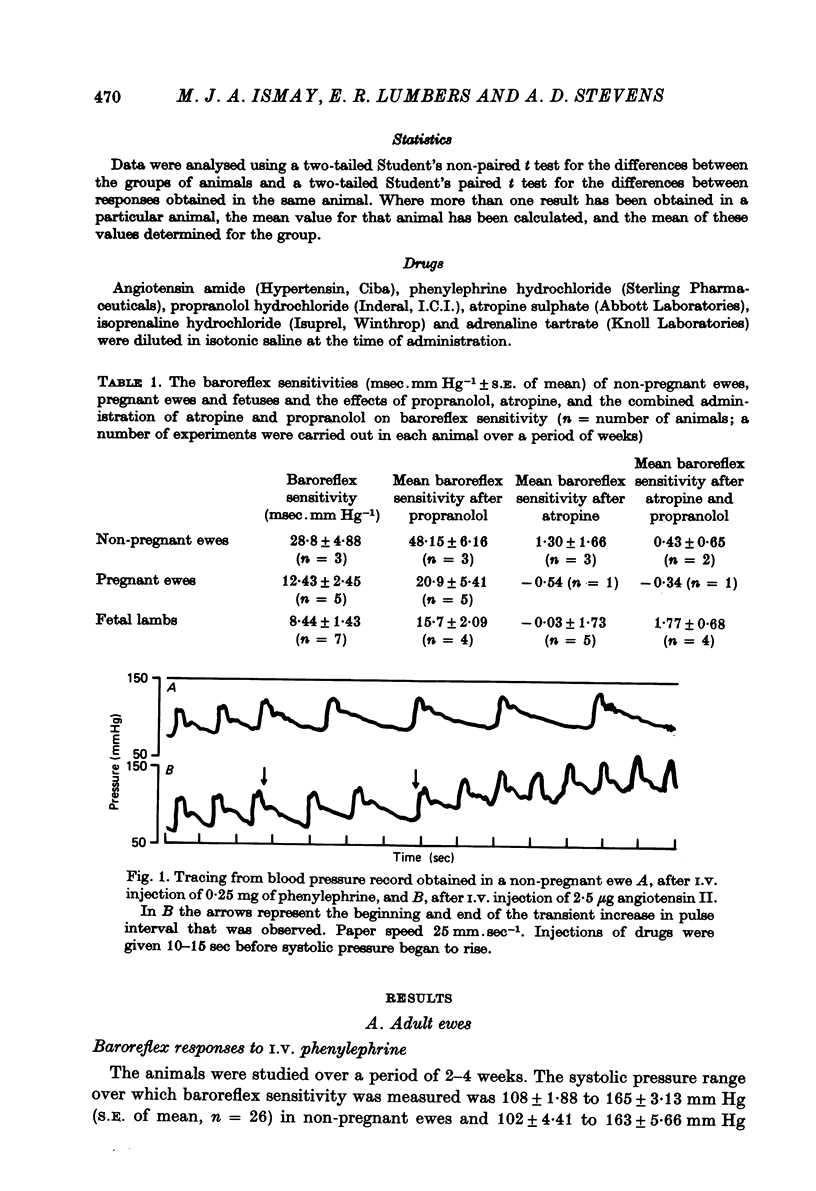
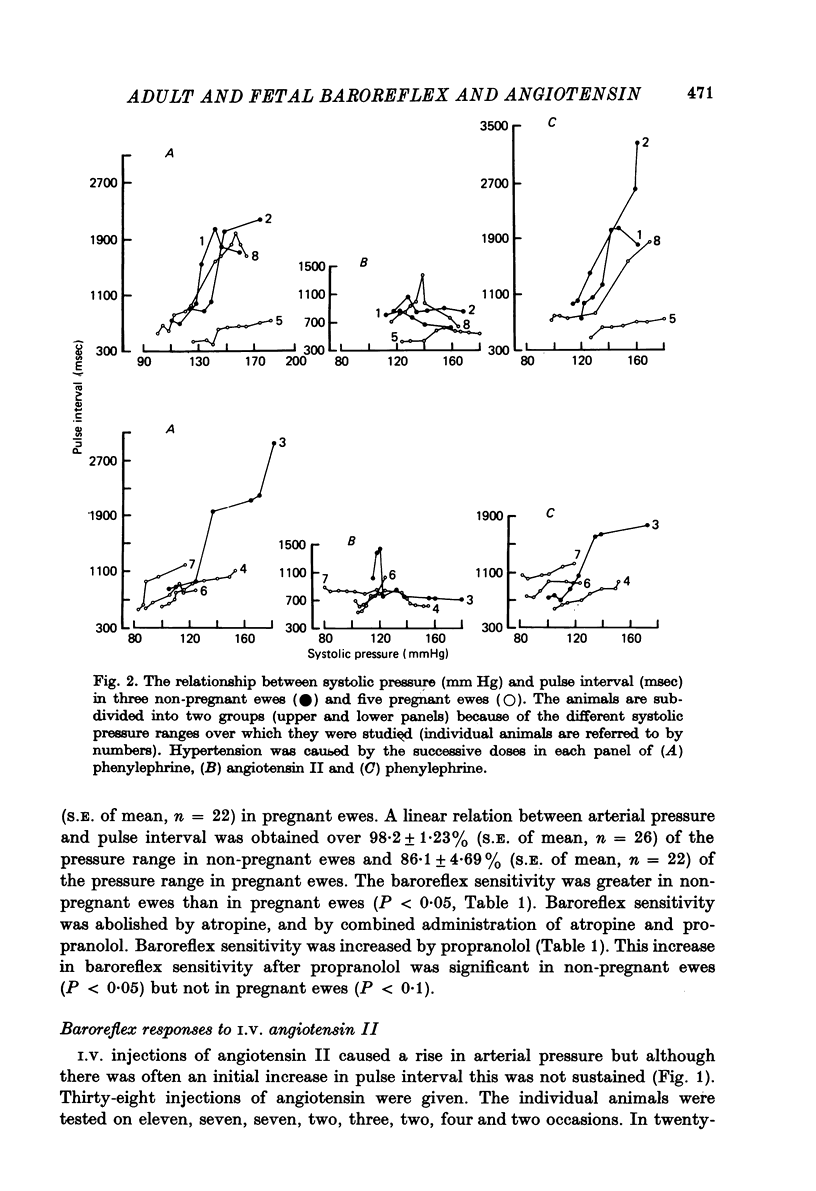

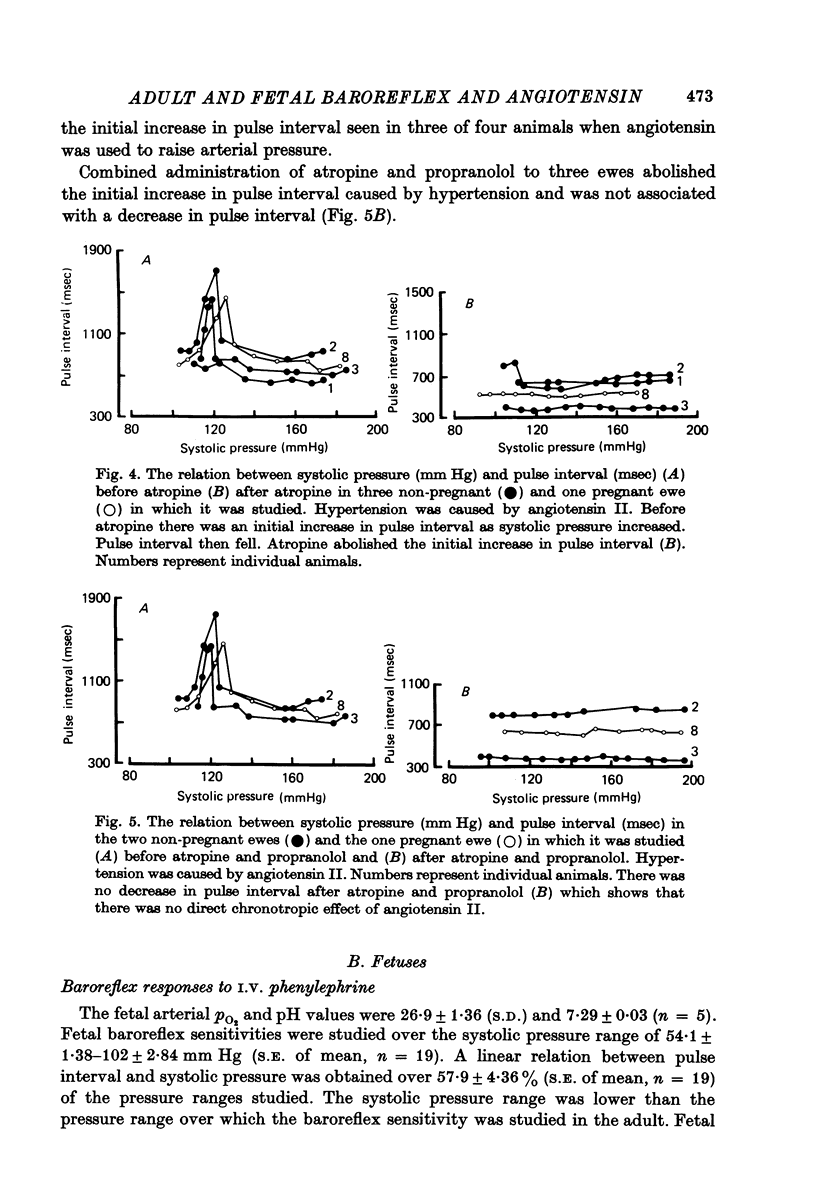
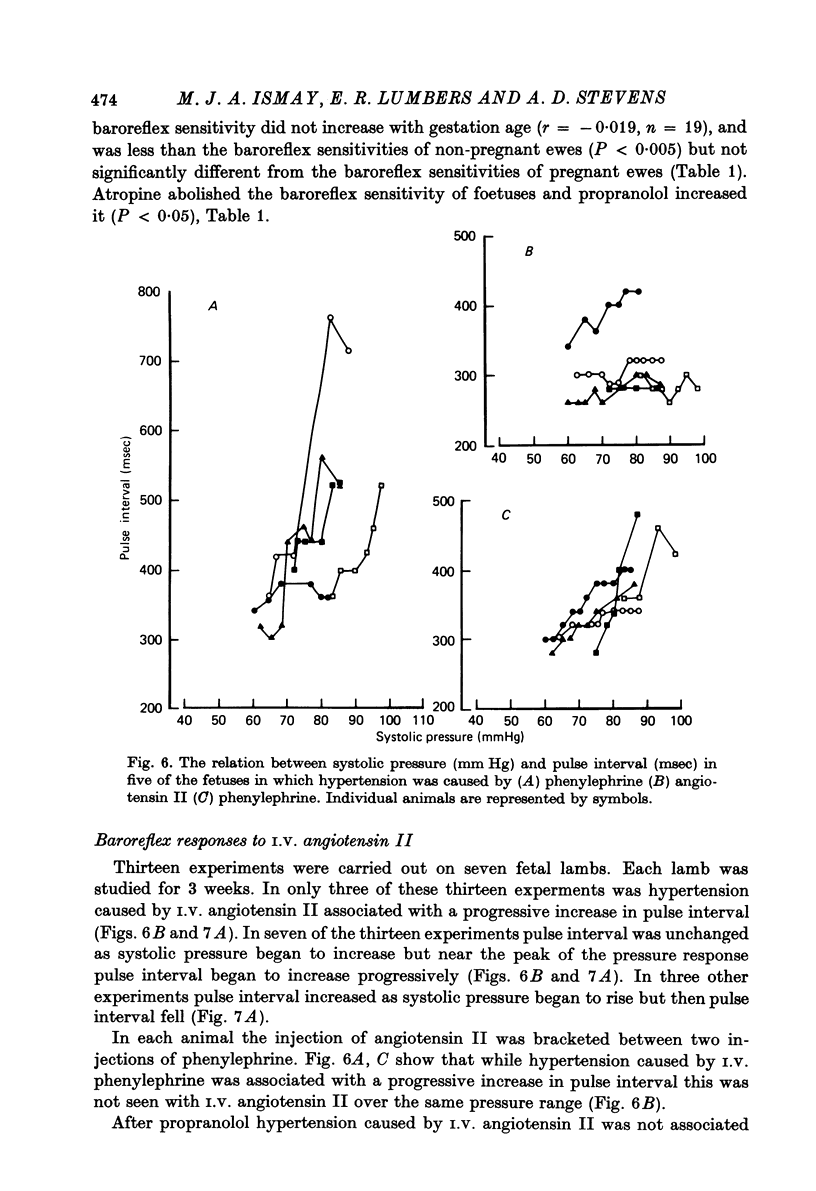
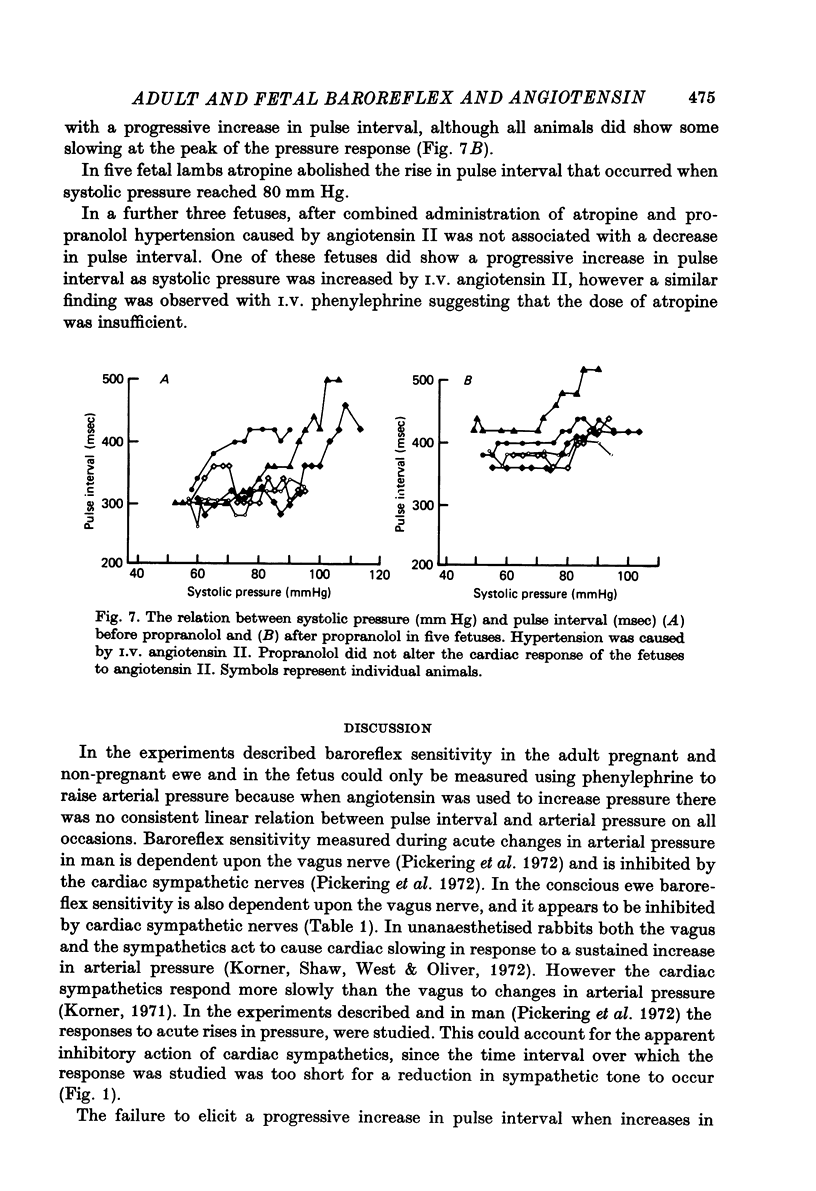
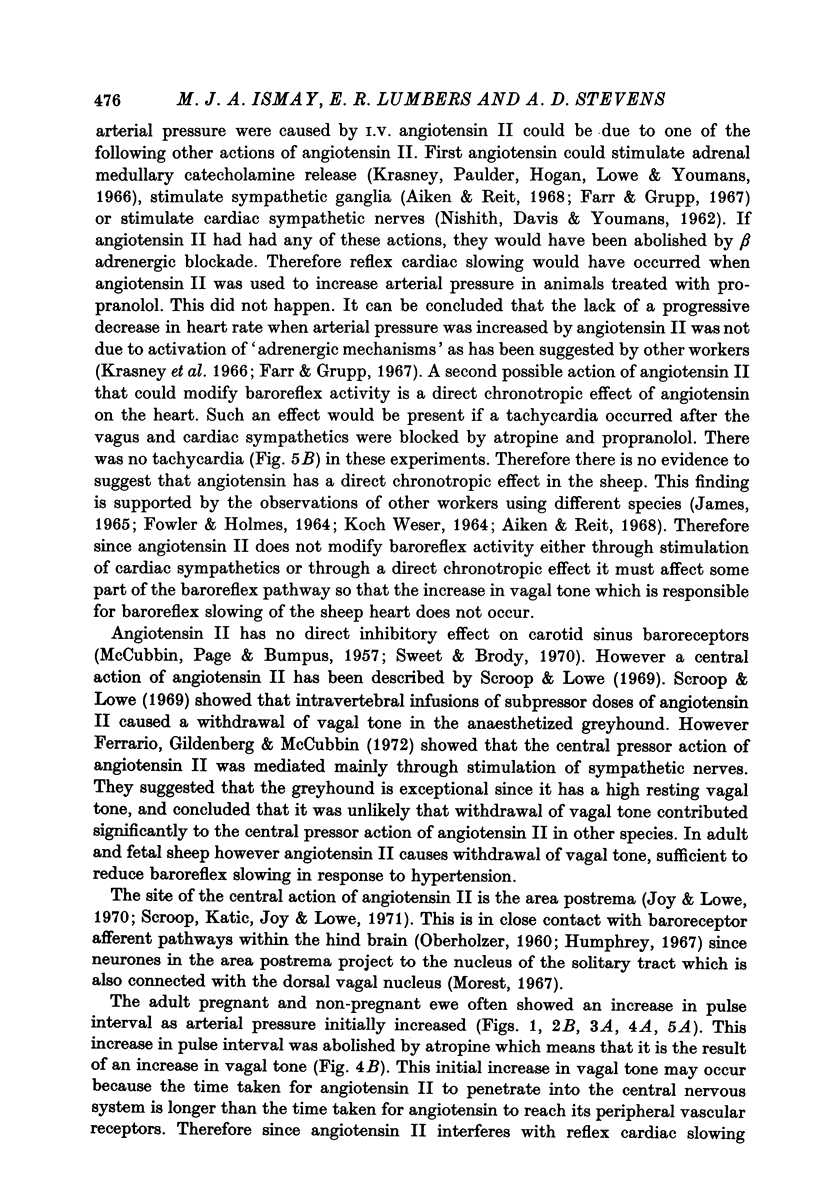
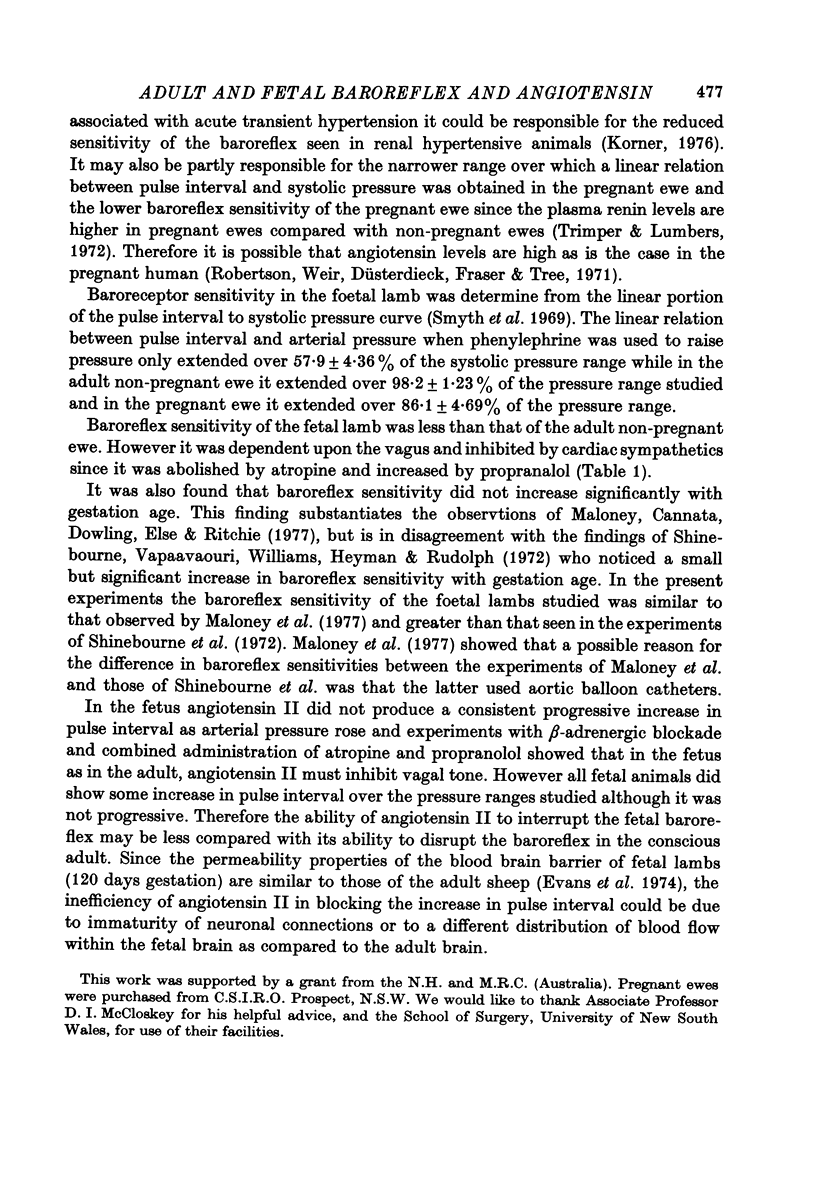
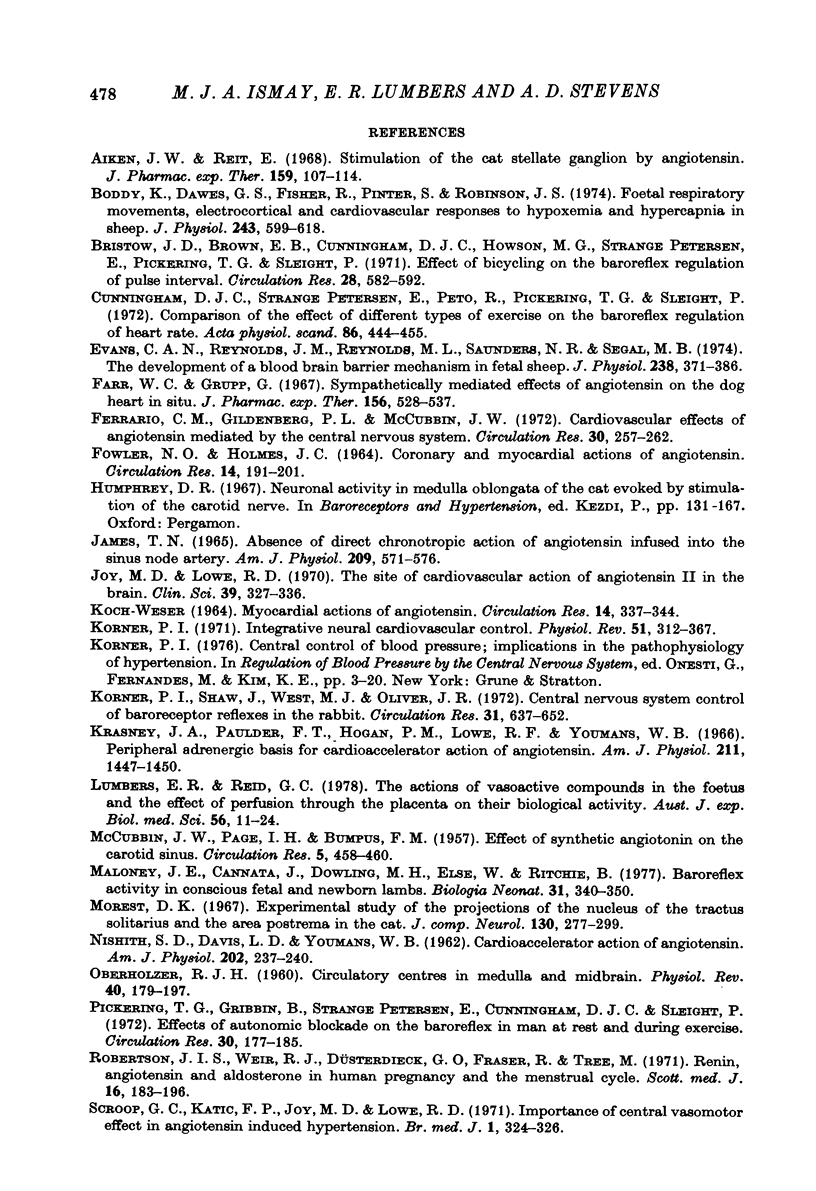

Selected References
These references are in PubMed. This may not be the complete list of references from this article.
- Aiken J. W., Reit E. Stimulation of the cat stellate ganglion by angiotensin. J Pharmacol Exp Ther. 1968 Jan;159(1):107–114. [PubMed] [Google Scholar]
- Boddy K., Dawes G. S., Fisher R., Pinter S., Robinson J. S. Foetal respiratory movements, electrocortical and cardiovascular responses to hypoxaemia and hypercapnia in sheep. J Physiol. 1974 Dec;243(3):599–618. doi: 10.1113/jphysiol.1974.sp010768. [DOI] [PMC free article] [PubMed] [Google Scholar]
- Cunningham D. J., Petersen E. S., Peto R., Pickering T. G., Sleight P. Comparison of the effect of different types of exercise on the baroreflex regulation of heart rate. Acta Physiol Scand. 1972 Dec;86(4):444–455. [PubMed] [Google Scholar]
- Evans C. A., Reynolds J. M., Reynolds M. L., Saunders N. R., Segal M. B. The development of a blood-brain barrier mechanism in foetal sheep. J Physiol. 1974 Apr;238(2):371–386. doi: 10.1113/jphysiol.1974.sp010530. [DOI] [PMC free article] [PubMed] [Google Scholar]
- FOWLER N. O., HOLMES J. C. CORONARY AND MYOCARDIAL ACTIONS OF ANGIOTENSIN. Circ Res. 1964 Mar;14:191–201. doi: 10.1161/01.res.14.3.191. [DOI] [PubMed] [Google Scholar]
- Farr W. C., Grupp G. Sympathetically mediated effects of angiotensin on the dog heart in situ. J Pharmacol Exp Ther. 1967 Jun;156(3):528–537. [PubMed] [Google Scholar]
- Ferrario C. M., Gildenberg P. L., McCubbin J. W. Cardiovascular effects of angiotensin mediated by the central nervous system. Circ Res. 1972 Mar;30(3):257–262. doi: 10.1161/01.res.30.3.257. [DOI] [PubMed] [Google Scholar]
- James T. N. Absence of direct chronotropic action of angiotensin infused into the sinus node artery. Am J Physiol. 1965 Sep;209(3):571–576. doi: 10.1152/ajplegacy.1965.209.3.571. [DOI] [PubMed] [Google Scholar]
- Joy M. D., Lowe R. D. The site of cardiovascular action of angiotensin II in the brain. Clin Sci. 1970 Aug;39(2):327–336. doi: 10.1042/cs0390327. [DOI] [PubMed] [Google Scholar]
- KOCH-WESER J. MYOCARDIAL ACTIONS OF ANGIOTENSIN. Circ Res. 1964 Apr;14:337–344. doi: 10.1161/01.res.14.4.337. [DOI] [PubMed] [Google Scholar]
- Korner P. I. Integrative neural cardiovascular control. Physiol Rev. 1971 Apr;51(2):312–367. doi: 10.1152/physrev.1971.51.2.312. [DOI] [PubMed] [Google Scholar]
- Korner P. I., Shaw J., West M. J., Oliver J. R. Central nervous system control of baroreceptor reflexes in the rabbit. Circ Res. 1972 Nov;31(5):637–652. doi: 10.1161/01.res.31.5.637. [DOI] [PubMed] [Google Scholar]
- Krasney J. A., Paudler F. T., Hogan P. M., Lowe R. F., Youmans W. B. Peripheral adrenergic basis for cardioaccelerator action of angiotensin. Am J Physiol. 1966 Dec;211(6):1447–1450. doi: 10.1152/ajplegacy.1966.211.6.1447. [DOI] [PubMed] [Google Scholar]
- Lumbers E. R., Reid G. C. The actions of vasoactive compounds in the foetus and the effect of perfusion through the placenta on their biological activity. Aust J Exp Biol Med Sci. 1978 Feb;56(1):11–24. doi: 10.1038/icb.1978.2. [DOI] [PubMed] [Google Scholar]
- MCCUBBIN J. W., PAGE I. H., BUMPUS F. M. Effect of synthetic angiotonin on the carotid sinus. Circ Res. 1957 Jul;5(4):458–460. doi: 10.1161/01.res.5.4.458. [DOI] [PubMed] [Google Scholar]
- Maloney J. E., Cannata J., Dowling M. H., Else W., Ritchie B. Baroreflex activity in conscious fetal and newborn lambs. Biol Neonate. 1977;31(5-6):340–350. doi: 10.1159/000240985. [DOI] [PubMed] [Google Scholar]
- Morest D. K. Experimental study of the projections of the nucleus of the tractus solitarius and the area postrema in the cat. J Comp Neurol. 1967 Aug;130(4):277–300. doi: 10.1002/cne.901300402. [DOI] [PubMed] [Google Scholar]
- NISHITH S. D., DAVIS L. D., YOUMANS W. B. Cardioaccelerator action of angiotensin. Am J Physiol. 1962 Feb;202:237–240. doi: 10.1152/ajplegacy.1962.202.2.237. [DOI] [PubMed] [Google Scholar]
- OBERHOLZER R. J. Circulatatory centers in medulla and midbrain. Physiol Rev Suppl. 1960 Apr;4:179–197. [PubMed] [Google Scholar]
- Pickering T. G., Gribbin B., Petersen E. S., Cunningham D. J., Sleight P. Comparison of the effects of exercise and posture on the baroreflex in man. Cardiovasc Res. 1971 Oct;5(4):582–586. doi: 10.1093/cvr/5.4.582. [DOI] [PubMed] [Google Scholar]
- Pickering T. G., Gribbin B., Petersen E. S., Cunningham D. J., Sleight P. Effects of autonomic blockade on the baroreflex in man at rest and during exercise. Circ Res. 1972 Feb;30(2):177–185. doi: 10.1161/01.res.30.2.177. [DOI] [PubMed] [Google Scholar]
- Robertson J. I., Weir R. J., Düsterdieck G. O., Fraser R., Tree M. Renin, angiotensin and aldosterone in human pregnancy and the menstrual cycle. Scott Med J. 1971 Mar;16(3):183–196. doi: 10.1177/003693307101600303. [DOI] [PubMed] [Google Scholar]
- Scroop G. C., Katic F., Joy M. D., Lowe R. D. Importance of central vasomotor effects in angiotensin-induced hypertension. Br Med J. 1971 Feb 6;1(5744):324–326. doi: 10.1136/bmj.1.5744.324. [DOI] [PMC free article] [PubMed] [Google Scholar]
- Scroop G. C., Lowe R. D. Efferent pathways of the cardiovascular response to vertebral artery infusions of angiotensin in the dog. Clin Sci. 1969 Dec;37(3):605–619. [PubMed] [Google Scholar]
- Shinebourne E. A., Vapaavuori E. K., Williams R. L., Heymann M. A., Rudolph A. M. Development of baroreflex activity in unanesthetized fetal and neonatal lambs. Circ Res. 1972 Nov;31(5):710–718. doi: 10.1161/01.res.31.5.710. [DOI] [PubMed] [Google Scholar]
- Smyth H. S., Sleight P., Pickering G. W. Reflex regulation of arterial pressure during sleep in man. A quantitative method of assessing baroreflex sensitivity. Circ Res. 1969 Jan;24(1):109–121. doi: 10.1161/01.res.24.1.109. [DOI] [PubMed] [Google Scholar]
- Sweet C. S., Brody M. J. Central inhibition of reflex vasodilatation by angiotensin and reduced renal pressure. Am J Physiol. 1970 Dec;219(6):1751–1758. doi: 10.1152/ajplegacy.1970.219.6.1751. [DOI] [PubMed] [Google Scholar]
- Trimper C. E., Lumbers E. R. The renin-angiotensin system in foetal lambs. Pflugers Arch. 1972;336(1):1–10. doi: 10.1007/BF00589136. [DOI] [PubMed] [Google Scholar]
- VARMA S., JOHNSEN S. D., SHERMAN D. E., YOUMANS W. B. Mechanisms of inhibition of heart rate by phenylephrine. Circ Res. 1960 Nov;8:1182–1186. doi: 10.1161/01.res.8.6.1182. [DOI] [PubMed] [Google Scholar]


